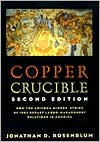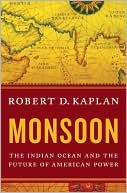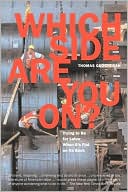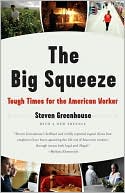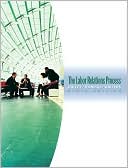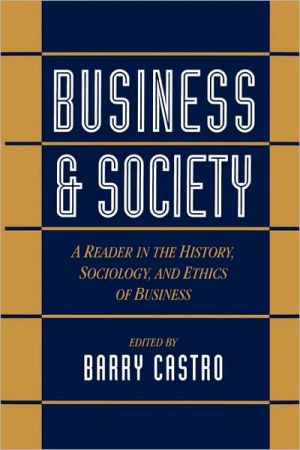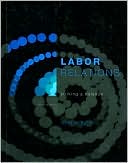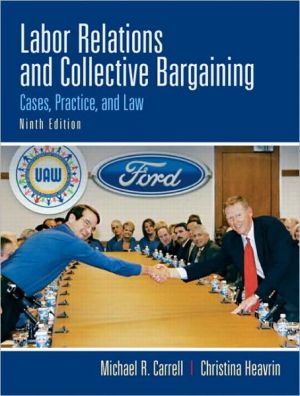Copper Crucible: How the Arizona Miner's Strike of 1983 Recast Labor-Management Relations in America
In this second edition of his in-depth and gripping account of the Arizona Miners' Strike of 1983, Jonathan D. Rosenblum describes in a new epilogue the resurgence of union activism at Steelworkers Local 890 in Silver City, New Mexico, more than a decade since the devastating campaign waged by the Phelps Dodge Corporation to obliterate the unions at its Arizona properties.
Search in google:
Jonathan D. Rosenblum describes the resurgence in 1996 and 1997 of union activism at Steelwarkers Local 890 in Silver City, New Mexico, the famous "Salt of the Earth" union. Phelps Dodge obliterated all the unions at its Arizona properties in the devastating 1983 campaign of permanent replacement documented in Copper Crucible. The company later acquired the China mine in wetern New Mexico; with the copper ore came the elements of union rebirth. Local 890 beat back Phelps Dodge's 1996 decertification campaign and, inspired by the union president's admonition that "We are still the salt of the earth," launched a community -wide campaign to resist the antiunion tactics of Phelps Dodge. Publishers Weekly The 1981 firing and replacing of striking air traffic controllers by President Ronald Reagan is considered the start of labor's current decline. Legal protection of employees' right to join unions is now often ineffective and the strike, once labor's most potent weapon, has been defanged by employers who use permanent replacements for striking workers. In his first book, lawyer and journalist Rosenblum argues convincingly that the crucial struggle over permanent replacements came not with PATCO (Professional Air Traffic Controllers Organization) but in the lesser-known 1983-1986 strike by the United Steelworkers of America against the Phelps Dodge copper company in Arizona and Texas. There, the company moved quickly to hire replacements. Over a year later, after picket-line violence (including a National Guard call-up by Governor Bruce Babbitt), much human tragedy, religious, racial and ethnic divisions among Phelps Dodge workers, an abortive union-sponsored corporate campaign and a lingering recession, replacement workers were legally allowed to vote the union out. And, with help from Phelps Dodge and an employer-friendly federal labor official, they did. Rosenblum chronicles this story with compassion and considerable objectivity. He portrays the strikers sympathetically but not uncritically, and his portrait of Phelps Dodge details the cooly self-interested executive decision-making processes, devoid of compassion for the employees. (Jan.)
Preface to the Second EditionAcknowledgmentsIntroduction: Critical Conditions3Ch. 1Workers of the World and Copper in Arizona13Ch. 2Hard Places46Ch. 3Midnight at Morenci81Ch. 4Copper Wars98Ch. 5Hard Times116Ch. 6Hard Change154Ch. 7Wars of Attrition166Ch. 8Slant of the Law185Conclusion: Angels and Demons200Epilogue: Life after Death?231Source Notes247Index265
\ From the Publisher"Jonathan D. Rosenblum's history of this one strike reveals to us, in chapter and verse, the barbaric use of power by the corporate big boys. It is a stunning metaphor for labor's trouble today."-Studs Terkel\ "Rosenblum writes with the verve of a good journalist and the empirical precision of a fine scholar. He is as deft at sketching brief portraits of key executives, union officials, and rank-and-file strikers as he is at untangling the legal skein in which the miners got fatally ensnared."-Michael Kazin, New York Times Book Review (reviewing the first edition)\ "Copper Crucible is a powerful analysis of labour-management relations in the American mining industry during the 1980's. It is also a powerful exposition of the influence individuals play in those relationships. By examining the dispute from a number of perspectives, Rosenblum has ensured that influences such as gender and ethnicity are not obscured in the overall analysis of the events."-Harry Knowles, Journal of Industrial Relations (reviewing the first edition)\ \ \ \ \ \ Publishers Weekly\ - Publisher's Weekly\ The 1981 firing and replacing of striking air traffic controllers by President Ronald Reagan is considered the start of labor's current decline. Legal protection of employees' right to join unions is now often ineffective and the strike, once labor's most potent weapon, has been defanged by employers who use permanent replacements for striking workers. In his first book, lawyer and journalist Rosenblum argues convincingly that the crucial struggle over permanent replacements came not with PATCO (Professional Air Traffic Controllers Organization) but in the lesser-known 1983-1986 strike by the United Steelworkers of America against the Phelps Dodge copper company in Arizona and Texas. There, the company moved quickly to hire replacements. Over a year later, after picket-line violence (including a National Guard call-up by Governor Bruce Babbitt), much human tragedy, religious, racial and ethnic divisions among Phelps Dodge workers, an abortive union-sponsored corporate campaign and a lingering recession, replacement workers were legally allowed to vote the union out. And, with help from Phelps Dodge and an employer-friendly federal labor official, they did. Rosenblum chronicles this story with compassion and considerable objectivity. He portrays the strikers sympathetically but not uncritically, and his portrait of Phelps Dodge details the cooly self-interested executive decision-making processes, devoid of compassion for the employees. (Jan.)\ \ \ Library JournalRosenblum, a lawyer and a journalist, gives an eyewitness account of the dramatic and ultimately unsuccessful 1983 strike by mostly Chicago miners in small Arizona mining towns against the Phelps Dodge company, all told against the backdrop of the uneasy relations between the company and the mine-workers' unions going back to 1903. Rosenblum contends that Phelps Dodge's move to hire permanent replacements for the strikers marked a fundamental change in American labor-management relations, giving employers an effective weapon for breaking lawful strikes. The chapters on the strike are written in an overheated style, but the discussion of the strike's larger consequences is calm and thoughtful. Suitable for academic libraries with labor union and industrial relations collections.-Harry Frumerman, formerly with Hunter Coll., CUNY\ \ \ \ \ John GilliomThe word "crucible" refers to cauldrons for melting ore, to fundamental tests of belief or faith, and to historical moments marked by a confluence of intense intellectual, economic, and political dynamics. Each of these meanings is central to Jonathan Rosenblum's narrative account of the 1983 copper miners' strike against the Phelps-Dodge Corporation; a strike that broke the miners' union, left its members stunned and jobless, and -- along with Reagan's firing of the Air Traffic Controllers -- helped set the tone for a decade or more of union busting in the United States. COPPER CRUCIBLE is difficult to summarize because of its narrative complexity and lack of a central thesis or argument. In telling the story of the strike, lawyer-journalist Rosenblum takes the reader back and forth among several main venues. The beautifully written work first pulls us into the context of the 1983 strike by describing the desert, the families, and the passions involved in the local struggle. The center of conflict involves the nearly contiguous Arizona towns of Clifton and Morenci; the former was the seat of the union, the latter, the company town and the site of the huge open pit mine from which the copper-rich ore was drawn. With the context thus set, COPPER CRUCIBLE turns to a history of the copper industry, the Phelps Dodge corporation, and the labor struggles in Arizona's copper mines; here the author shows how the earlier eras of armed conflict and tense cooperation between labor and management set the stage for the standoff of 1983. But if history set the stage, Rosenblum makes it clear that Phelps Dodge executives wrote most of the script. He shows how Phelps Dodge leaders set their sights on breaking the union, obtained strategic advice from faculty members at the Wharton School, and moved into battle with almost unflinching adherence to a strategy of union destruction. In a nutshell, the plan was to demand major concessions -- including the death of longstanding cost-of-living-adjustment (COLA) provisions -- which would force an inevitable strike. As the strike endured in the face of a unmoving corporate position, Phelps Dodge would hire, protect, and promote permanent replacement workers, who would in turn decertify the union. On the other side, we see a hometown and largely Chicano union local approaching a normal strike in the three year contract cycle with no apparent sense that a grander war was in the making. As the Phelps Dodge strategy is deployed at the negotiation table and the Morenci mine, the strikers go through a slow and dreadful recognition that this was no normal negotiations strike -- replacement workers came and they were permanent. Under the leadership of the United Steelworkers of America, the strike went forward without concession and as months turned into years, the permanent replacement workers finally fulfilled the Phelps Dodge plan by decertifying the union itself. In the process, children were shot in their beds, the National Guard was mobilized, citizens were teargassed, homes were lost, and a longstanding union town was all but destroyed. Through it all, Rosenblum tells the story with passion and Page 152 follows: sensitivity and makes no bones about this being a tale of good and evil -- a David and Goliath story in which Goliath wins. In some ways, COPPER CRUCIBLE is an odd book for inclusion in THE LAW AND POLITICS BOOK REVIEW. It has no explicit reference to any academic work on law, the politics of law, or law and labor relations. It has no explicit theory of any kind; there are no discussions of the politics of rights, of the politics of social movements, of the ideology of law, of legal hegemony, of the political economy of law, or of any of the other things academics might toy with. If there is an implicit theory of power and law, it is a combination of simple pluralism (in which individuals and groups go to battle using whatever resources they can mobilize) and legal realism (in which the law is whatever the often corrupt judges and NLRB administrators say it is). But this absence of explicit theory does not leave this narrative wanting for relevance to the field. We see a history of the legal politics surrounding organizing efforts in the Arizona copper mines (which includes a young Felix Frankfurter mediating an early Phelps Dodge labor conflict in Arizona and then ruling against the company's anti-union tactics in Phelps Dodge v. Labor Board (1941)). We see how the unions' faith in a pre-Reagan framing of labor law pushed them toward tactics that failed in the new environment. We see the conspiring between the corporation, local police, local officials and the state police in a successful effort to use the coercive powers of law against the unions. And we see the union able to turn some aspects of labor law into concessions from the corporation. In short, we see many of the things that a more academic treatment would include, absent the extensive analysis and footnoting. Because it is compelling reading (truly a page turner) and chock full of anecdotes and vignettes regarding the multi-faceted influence of law in political and economic struggle, COPPER CRUCIBLE could be an excellent addition to courses related to law and politics. The role it could play is that of "raw data" for the course -- an empirical narrative of an intense and multi-faceted moment of struggle in which law plays a central role. As a reading that does not push its own explicit theories of law or "law and . . ." issues, the book would promote a dialogue in which a class would move toward its own theories and explanations. In this sense, COPPER CRUCIBLE, could begin a course by encouraging creative analysis of the subject, or conclude a course by inviting students to apply different academic perspectives to the Arizona case. As a moving and passionately told story of human struggle and defeat, the book would be sure to generate compelling discussions of law's role in our world.\ \
